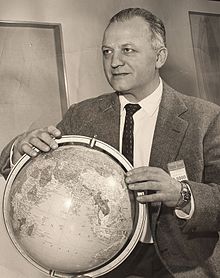Fritz Karl Preikschat
| Fritz Karl Preikschat | |
|---|---|

Preikschat at Boeing (~1965)
|
|
| Born |
Fritz Karl Preikschat September 11, 1910 Finkengrund, Prussia, Germany |
| Died | September 2, 1994 (aged 83) Kirkland, Washington, U.S. |
| Nationality | German, American |
| Citizenship | Germany United States (after 1962) |
| Alma mater | Hindenburg Polytechnic |
| Occupation | Engineer and inventor |
| Spouse(s) | Martha Wasgindt (m. 1937-1994) |
| Children | Ursula Gallagher Ekhard Preikschat |
Fritz Karl Preikschat (September 11, 1910 – September 2, 1994) was a German, later American, electrical and telecommunications engineer and inventor. He had more than three German patents and more than 23 U.S. patents, including a dot matrix teletypewriter (Germany, 1957), a blind-landing system for airports (1965), a phased array system for satellite communications (1971), a hybrid car system (1982), and a scanning laser diode microscope for particle analysis (1989).
In 1934, he graduated from Hindenburg Polytechnic in Oldenburg, Germany with a degree in "Elektrotechnik" (electrical engineering). He then served in a minesweeper unit of Kriegsmarine (German Navy).
From 1940–1945 (during WW2), he worked as an engineer at GEMA, mostly in the radar group (see Radar in World War II). At the end of WW2, his family fled to Dresden and survived (except for one relative) the Bombing of Dresden in World War II. His family then resettled as refugees in the Bavarian town of Amberg.
In 1946, he was one of the more than two thousand German specialists forcibly (at gunpoint) brought to Russia under Operation Osoaviakhim. He was then one of the more than 170 German specialists – headed by Helmut Gröttrup - brought to Branch 1 of NII-88 on Gorodomlya Island in Lake Seliger. From 1946–1952, he was an engineer and manager of a radar electronics lab, working on the hardware for a new radar guidance system for the early Soviet rocket program. He also worked on a design for a 6-dish (array) deep-space tracking station for the early Soviet space program. In 1960, Russia implemented the full 8-dish (with 60-foot diameter dishes) deep-space tracking station called Pluton in the Crimea.
...
Wikipedia
